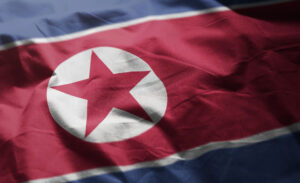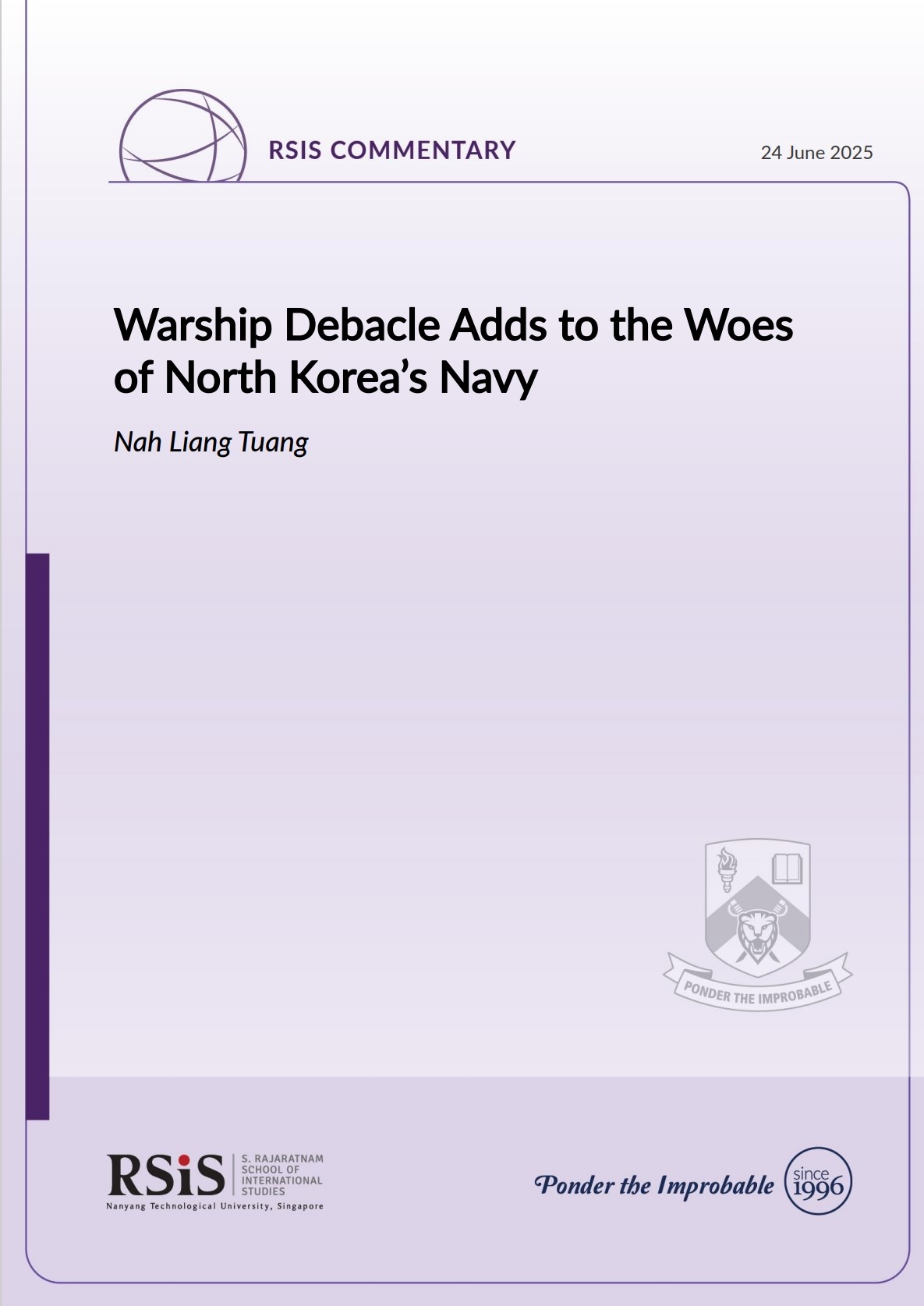24 June 2025
- RSIS
- Publication
- RSIS Publications
- Warship Debacle Adds to the Woes of North Korea’s Navy
SYNOPSIS
The botched launching of the Choe Hyon-class destroyer was a setback to Kim Jong-un’s ambition of transforming his coastal navy into a blue-water fleet. Besides being a major embarrassment for Kim, the debacle has only added to the operational constraints and potential of the North Korean navy. It also reflects that there is no shortcut to providing quality hardware and having competent expertise in modernising the military and its capability to defend and to wage war.

COMMENTARY
In pursuing naval modernisation, Pyongyang decided to acquire guided missile destroyers, a class of naval vessels operated mainly by the navies of industrialised nations, including its adversary, South Korea. Acquisition of such destroyers would be a quantum leap for North Korea, as its most capable surface combatants were two old Najin-class frigates built in the 1970s.
Although one of these two frigates was modernised in 2014 to give it anti-ship missiles and close-range defensive capabilities, it was, at best, on par with South Korea’s smaller Pohang-class corvettes and Yoon Youngha-class patrol craft.
Pyongyang decided to build two Choe Hyon-class guided missile destroyers, which were likely worth the equivalent of about US$1.4 billion (based on the 2002 cost that China paid Russia to buy two broadly comparable ships).
The first of these destroyers was successfully launched on 25 April 2025 at Nampo shipyard on North Korea’s west coast. It was installed with Vertical Launch Systems (VLS) integrated into the ship’s structure, which enabled it to carry up to 82 missiles, far exceeding the Najin-class’s capability.
More importantly, the VLS is reportedly capable of launching nuclear-tipped cruise and tactical ballistic missiles at land targets, making the Choe Hyon-class warship a significant strategic and not merely a tactical threat.
Indeed, the Choe Hyon’s teeth were showcased for the first time on the last week of April, just days after the launch, when North Korean President Kim Jong-un personally viewed the test firing of cruise and anti-aircraft missiles from the newly-launched vessel.
On 21 May, barely a month after the launch of the first Choe Hyon destroyer, the second vessel of the series was launched from the Hambuk shipyard in Chongjin, on the eastern coast of North Korea. However, disaster struck when the ship, launched sideways into the water, lost balance and keeled over onto its side. Although Pyongyang has since restored the stricken vessel to an upright position, naval analysts assess that damage to the hull is severe and that the ship might have to be scrapped eventually.
The botched launch showed that the launching facilities and/or shipyard personnel were unprepared. Furthermore, the failure to safely launch a 5,000-ton warship implies that North Korean shipyards on its eastern coast might lack the competence for serious naval construction, substantially denting Kim Jong-un’s ambitions.
Other factors will hinder the Korean People’s Navy (KPA). One of these is unfavourable geography as the KPA’s ships on the west coast cannot or will find it highly challenging to sail around the Korean peninsula to reinforce KPA assets on the east coast, with the vice versa being true.
This is primarily because most of the KPA’s older ships do not have the range to journey in either direction. As for the one successfully launched Choe Hyon destroyer, based on the west coast, it would have to sail through the Yellow Sea in waters dominated by the technologically and experientially superior South Korean navy to support the KPN’s eastern fleet. In peacetime, this destroyer would certainly be closely monitored and tracked. In wartime, it would be quickly sunk.
In peacetime, the Najin-class frigates based in the east would be closely monitored if they tried to sail west and, in wartime, be confined to the northern half of the Sea of Japan, as sortieing southwards would put them at risk of being eliminated by the South Korean navy or the superior warships of the Japanese Maritime Self-Defence Force.
North Korea’s moribund economy, combined with strict arms embargoes imposed by the UN, means that the Pyongyang authorities lack the funds to import arms, while global arms producers are prohibited from selling to the DPRK. Hence, its military hardware must be produced locally using imported technologies and/or production processes acquired illegally through barter trade involving goods or services.
Even if Russia, North Korea’s ally, indirectly assists in the DPRK’s military modernisation, there are limits on how far Pyongyang can arm its military forces with the latest equipment, notwithstanding the construction of the Choe Hyon-class destroyers.
And, even if the salvaged Choe Hyon-class destroyer is restored to full operational capacity, the KPA’s pride has been severely dented. More significantly, the two destroyers will not substantially increase North Korea’s maritime capability, rendering Kim Jong-un’s ambition of transforming the KPA from a primarily coastal navy into a blue-water fleet a distant dream.
In conclusion, this “accident” shows that there is no shortcut to military modernisation, particularly in the localised construction and production of military equipment and infrastructure. The difficulty is made worse by the severe sanctions regime the DPRK is under, and the limited technical assistance Russia is providing to Pyongyang for one reason or another. Nevertheless, Kim Jong-un is not likely to relent and is expected to continue pushing for more expertise, hardware, and technology from those governments that need the DPRK’s support.
About the Author
Nah Liang Tuang, PhD, is a Research Fellow at the Institute of Defence and Strategic Studies (IDSS), a constituent unit of the S. Rajaratnam School of International Studies (RSIS), Nanyang Technological University (NTU), Singapore. His research specialities include nuclear weapons’ politics, North Korean affairs and the role of nationalism in the defence of small states.
SYNOPSIS
The botched launching of the Choe Hyon-class destroyer was a setback to Kim Jong-un’s ambition of transforming his coastal navy into a blue-water fleet. Besides being a major embarrassment for Kim, the debacle has only added to the operational constraints and potential of the North Korean navy. It also reflects that there is no shortcut to providing quality hardware and having competent expertise in modernising the military and its capability to defend and to wage war.

COMMENTARY
In pursuing naval modernisation, Pyongyang decided to acquire guided missile destroyers, a class of naval vessels operated mainly by the navies of industrialised nations, including its adversary, South Korea. Acquisition of such destroyers would be a quantum leap for North Korea, as its most capable surface combatants were two old Najin-class frigates built in the 1970s.
Although one of these two frigates was modernised in 2014 to give it anti-ship missiles and close-range defensive capabilities, it was, at best, on par with South Korea’s smaller Pohang-class corvettes and Yoon Youngha-class patrol craft.
Pyongyang decided to build two Choe Hyon-class guided missile destroyers, which were likely worth the equivalent of about US$1.4 billion (based on the 2002 cost that China paid Russia to buy two broadly comparable ships).
The first of these destroyers was successfully launched on 25 April 2025 at Nampo shipyard on North Korea’s west coast. It was installed with Vertical Launch Systems (VLS) integrated into the ship’s structure, which enabled it to carry up to 82 missiles, far exceeding the Najin-class’s capability.
More importantly, the VLS is reportedly capable of launching nuclear-tipped cruise and tactical ballistic missiles at land targets, making the Choe Hyon-class warship a significant strategic and not merely a tactical threat.
Indeed, the Choe Hyon’s teeth were showcased for the first time on the last week of April, just days after the launch, when North Korean President Kim Jong-un personally viewed the test firing of cruise and anti-aircraft missiles from the newly-launched vessel.
On 21 May, barely a month after the launch of the first Choe Hyon destroyer, the second vessel of the series was launched from the Hambuk shipyard in Chongjin, on the eastern coast of North Korea. However, disaster struck when the ship, launched sideways into the water, lost balance and keeled over onto its side. Although Pyongyang has since restored the stricken vessel to an upright position, naval analysts assess that damage to the hull is severe and that the ship might have to be scrapped eventually.
The botched launch showed that the launching facilities and/or shipyard personnel were unprepared. Furthermore, the failure to safely launch a 5,000-ton warship implies that North Korean shipyards on its eastern coast might lack the competence for serious naval construction, substantially denting Kim Jong-un’s ambitions.
Other factors will hinder the Korean People’s Navy (KPA). One of these is unfavourable geography as the KPA’s ships on the west coast cannot or will find it highly challenging to sail around the Korean peninsula to reinforce KPA assets on the east coast, with the vice versa being true.
This is primarily because most of the KPA’s older ships do not have the range to journey in either direction. As for the one successfully launched Choe Hyon destroyer, based on the west coast, it would have to sail through the Yellow Sea in waters dominated by the technologically and experientially superior South Korean navy to support the KPN’s eastern fleet. In peacetime, this destroyer would certainly be closely monitored and tracked. In wartime, it would be quickly sunk.
In peacetime, the Najin-class frigates based in the east would be closely monitored if they tried to sail west and, in wartime, be confined to the northern half of the Sea of Japan, as sortieing southwards would put them at risk of being eliminated by the South Korean navy or the superior warships of the Japanese Maritime Self-Defence Force.
North Korea’s moribund economy, combined with strict arms embargoes imposed by the UN, means that the Pyongyang authorities lack the funds to import arms, while global arms producers are prohibited from selling to the DPRK. Hence, its military hardware must be produced locally using imported technologies and/or production processes acquired illegally through barter trade involving goods or services.
Even if Russia, North Korea’s ally, indirectly assists in the DPRK’s military modernisation, there are limits on how far Pyongyang can arm its military forces with the latest equipment, notwithstanding the construction of the Choe Hyon-class destroyers.
And, even if the salvaged Choe Hyon-class destroyer is restored to full operational capacity, the KPA’s pride has been severely dented. More significantly, the two destroyers will not substantially increase North Korea’s maritime capability, rendering Kim Jong-un’s ambition of transforming the KPA from a primarily coastal navy into a blue-water fleet a distant dream.
In conclusion, this “accident” shows that there is no shortcut to military modernisation, particularly in the localised construction and production of military equipment and infrastructure. The difficulty is made worse by the severe sanctions regime the DPRK is under, and the limited technical assistance Russia is providing to Pyongyang for one reason or another. Nevertheless, Kim Jong-un is not likely to relent and is expected to continue pushing for more expertise, hardware, and technology from those governments that need the DPRK’s support.
About the Author
Nah Liang Tuang, PhD, is a Research Fellow at the Institute of Defence and Strategic Studies (IDSS), a constituent unit of the S. Rajaratnam School of International Studies (RSIS), Nanyang Technological University (NTU), Singapore. His research specialities include nuclear weapons’ politics, North Korean affairs and the role of nationalism in the defence of small states.





